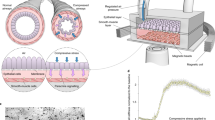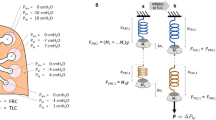Abstract
The forces of parenchymal interdependence in the lung are potent inhibitors of airway smooth muscle shortening, as evidenced by the marked dependence of bronchial responsiveness on lung volume. In this study we developed a mathematical-computer model of the effects of parenchymal interdependence on airway smooth muscle shortening. A three-dimensional network of cuboidal alveolar walls was tethered at its boundaries and surrounded a single airway with mechanical properties identical to the alveolar parenchyma. The walls were assigned highly nonlinear properties so that the pressure-volume behavior of the model matched that measured in dogs. Constriction of the airway was achieved by increasing the circumferential tension in the airway wall, and then solving the force-balance equations of the model to calculate the equilibrium configurations of the airway wall and all the interconnecting alveolar walls. The changes in airway resistance predicted by the model at various transpulmonary pressures (P tp were compared to those obtained by the alveolar capsule oscillator technique in dogs during induced bronchoconstriction at various P tp (Balassy et al., J. Appl. Physiol. 78:875–880, 1995). The model matched the data reasonably well at P tp values above about 0.5 kPa, but was too responsive at lower P tp We were able to make the model match the data at all P tpby including an additional stiffness term, such as might conceivably arise from the airway wall itself. ©
Similar content being viewed by others
References
Adler, A., E. A. Cowley, J. H. T. Bates, and D. H. Eidelman. Airway-parenchymal interdependence following airway contraction in rat lung explants. J. Appl. Physiol.85:231-237, 1998.
Angus, G. E., and W. M. Thurlbeck. Number of alveoli in the human lung. J. Appl. Physiol.32:483-485, 1972.
Balassy, Z., M. Mishima, and J. H. T. Bates. Changes in regional lung impedance after intravenous histamine bolus in dogs: Effects of lung volume. J. Appl. Physiol.78:875-880, 1995.
Bates, J. H. T., A.-M. Lauzon, G. S. Dechman, G. N. Maksym, and T. F. Schuessler. Temporal dynamics of pulmonary response to intravenous histamine in dogs: Effects of dose and lung volume. J. Appl. Physiol.76:616-626, 1994.
Brown, X., and X. Mitzner. Effect of lung inflation and airway muscle tone on airway diameter in vivo. J. Appl. Physiol. 80:1581–1588.
Davey, B. L. K., and J. H. T. Bates. Regional lung impedance from forced oscillations through alveolar capsules. Respir. Physiol.91:165-182, 1993.
Ding, D. J., J. G. Martin, and P. T. Macklem. Effects of lung volume on maximal methacholine-induced bronchoconstriction in normal humans. J. Appl. Physiol.62:1324-1330, 1987.
Ebina, M., T. Takahashi, T. Chiba, and M. Motomiya. Cellular hypertrophy and hyperplasia of airway smooth muscles underlying bronchial asthma. Am. Rev. Respir. Dis.148:720-726, 1993.
Fukaya, H., C. J. Martin, A. C. Young, and S. Kaysura. Mechanical properties of alveolar walls. J. Appl. Physiol.25:689-695, 1968.
Gunst, S. J., D. O. Warner, T. A. Wilson, and R. E. Hyatt. Parenchymal interdependence and airway response to methacholine in excised dog lobes. J. Appl. Physiol.65:2490-2497, 1988.
Hajji, M. A., T. A. Wilson, and S. J. Lai-Fook. Improved measurements of shear modulus and pleural membrane tension of the lung. J. Appl. Physiol.47:175-181, 1979.
Hill, M. J., T. A. Wilson, and R. K. Lambert. Effects of surface tension and intraluminal fluid on mechanics of small airways. J. Appl. Physiol.82:233-239, 1997.
Horsfield, K., W. Kemp, and S. Philips. An asymmetrical model of the airways of the dog lung. J. Appl. Physiol. 52:21–26, 1982.
Kenyon, C. M., and P. T. Macklem. Modelling parenchymal shear modulus using a force balance analysis for large strains. Am. Rev. Respir. Dis.147:A963, 1993.
Kimmel, E., and B. Budiansky. Surface tension and the dodecahedron model for lung elasticity. Trans. ASME, J. Biomech. Eng. 112:160–167, 1990.
Lai-Fook, S. J., R. E. Hyatt, J. R. Rodarte, and T. A. Wilson. Behavior of artificially produced holes in lung parenchyma. J. Appl. Physiol. 43:648–655, 1977.
Lai-Fook, S. J. A continuum mechanics analysis of pulmonary vascular interdependence in isolated dog lobes. J. Appl. Physiol. 46:419–429, 1979.
Lambert, R. K., S. L. Codd, M. R. Alley, and R. J. Pack. Physical determinants of bronchial mucosal folding. J. Appl. Physiol.77:1206-1216, 1994.
Lambert, R. K., and P. D. Paré. Lung parenchymal shear modulus, airway wall remodeling, and bronchial hyperresponsiveness. J. Appl. Physiol.83:140-147, 1997.
Lauzon, A.-M., G. Dechman, and J. H. T. Bates. On the use of the alveolar capsule technique to study bronchoconstriction. Respir. Physiol.99:139-146, 1995.
Macklem, P. T., Bronchial hyperresponsiveness. Chest87:1585-1595, 1985.
Macklem, P. T. A theoretical analysis of the effect of airway smooth muscle load on airway narrowing. Am. J. Respir. Crit. Care Med.153:83-89, 1996.
Mead, J., T. Takishima, and D. Leith. Stress distribution in lungs: A model of pulmonary elasticity. J. Appl. Physiol.28:596-608, 1970.
Mishima, M., Z. Balassy, and J. H. T. Bates. Assessment of local lung impedance by the alveolar capsule oscillator in dogs: A model analysis. J. Appl. Physiol.80:1165-1172, 1996.
Moreno, R. H., C. Lisboa, J. C. Hogg, and P. D. Pare. Limitation of airway smooth muscle shortening by cartilage stiffness and lung elastic recoil in rabbits. J. Appl. Physiol.75:738-744, 1993.
Nagase, T., J. G. Martin, and M. S. Ludwig. Comparative study of mechanical interdependence: Effect of lung volume on raw during induced constriction. J. Appl. Physiol.75:2500-2505, 1993.
Robatto, F. M., S. Simard, H. Orana, P. T. Macklem, and M. S. Ludwig. Effect of lung volume on plateau response of airways and tissue to methacholine in dogs. J. Appl. Physiol.73:1908-1913, 1992.
Sasaki, H., F. G. Hoppin, Jr., and T. Takishima. Peribronchial pressure in excised dog lungs. J. Appl. Physiol.45:858-869, 1978.
Sasaki, H., and F. G. Hoppin, Jr. Hysteresis of contracted airway smooth muscle. J. Appl. Physiol.47:1251-1262, 1979.
Sorenson, H. W. Parameter Estimation. New York: Marcel Dekker, 1980, pp. 61–65.
Stamenovic, D., and T. A. Wilson. A strain energy function for lung parenchyma. ASME J. Biomech. Eng.107:81-86, 1985.
Stamenovic, D., and J. C. Smith. Surface forces in lungs. III. Alveolar surface tension and elastic properties of lung parenchyma. J. Appl. Physiol.60:1358-1362, 1986.
Sugihara, T., C. J. Martin, and J. Hildebrandt. Length-tension properties of alveolar will in man. J. Appl. Physiol.30:874-878, 1971.
Wiggs, B. R., R. Moreno, J. C. Hogg, C. Hilliam, and P. D. Paré. A model of the mechanics of airway narrowing. J. Appl. Physiol.69:849-860, 1990.
Wiggs, B. R., C. A. Hrousis, J. M. Drazen, and R. D. Kamm. On the mechanism of mucosal folding in normal and asthmatic airways. J. Appl. Physiol.83:1814-1821, 1997.
Wilson, T. A. A continuum analysis of a two-dimensional mechanical model of the lung parenchyma. J. Appl. Physiol.33:472-478, 1972.
Rights and permissions
About this article
Cite this article
Adler, A., Bates, J.H.T. A Micromechanical Model of Airway-Parenchymal Interdependence. Annals of Biomedical Engineering 28, 309–317 (2000). https://doi.org/10.1114/1.270
Issue Date:
DOI: https://doi.org/10.1114/1.270




